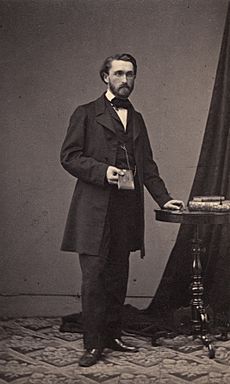Richard Dedekind facts for kids
Quick facts for kids
Richard Dedekind
|
|
|---|---|
 |
|
| Born | 6 October 1831 Braunschweig, Duchy of Brunswick
|
| Died | 12 February 1916 (aged 84) |
| Nationality | German |
| Alma mater | Collegium Carolinum University of Göttingen |
| Known for | Dedekind cut Dedekind-Peano axioms Abstract algebra Algebraic number theory Real numbers Logicism |
| Scientific career | |
| Fields | Mathematics Philosophy of mathematics |
| Doctoral advisor | Carl Friedrich Gauss |
Richard Dedekind (born October 6, 1831 – died February 12, 1916) was a German mathematician. He made big contributions to number theory (the study of numbers) and abstract algebra (a type of math that looks at structures). He also helped set up the basic rules for arithmetic (math with numbers).
Dedekind is best known for his idea of a "Dedekind cut". This helped define real numbers, which include all numbers on a number line. He was also a leader in developing modern set theory (the study of collections of objects). He also contributed to a way of thinking about math called Logicism.
Life of Richard Dedekind
Richard Dedekind was born in Braunschweig, Germany. His father, Julius Levin Ulrich Dedekind, was an administrator at a school called Collegium Carolinum. His mother was Caroline Henriette Dedekind. Richard was the youngest of four children. He lived most of his life in Braunschweig and died there.
In 1848, he started studying at the Collegium Carolinum. Then, in 1850, he moved to the University of Göttingen. There, he learned number theory from Professor Moritz Stern. Carl Friedrich Gauss, a very famous mathematician, was still teaching. Dedekind became Gauss's last student.
Richard Dedekind earned his doctorate degree in 1852. His thesis was about "Eulerian integrals." After that, he studied for two years in Berlin. He and Bernhard Riemann, another important mathematician, were students at the same time.
Dedekind returned to Göttingen to teach. He gave classes on probability and geometry. He also studied with Peter Gustav Lejeune Dirichlet, and they became good friends. Dedekind was one of the first people at Göttingen to teach about Galois theory. He also understood how important the idea of groups was for algebra and arithmetic.
In 1858, Dedekind started teaching at the Polytechnic school in Zürich. In 1862, he went back to his hometown, Braunschweig. He taught at the Institute there for the rest of his life. He retired in 1894 but kept teaching sometimes and publishing his work. He never got married and lived with his sister, Julia.
Dedekind was recognized for his work. He became a member of important science groups in Berlin, Rome, and France. He also received special honorary degrees from universities in Oslo, Zurich, and Braunschweig.
Dedekind's Important Work
While teaching math, Dedekind came up with an idea called a "Dedekind cut". This is now a standard way to define real numbers. Imagine all the numbers on a number line. A Dedekind cut divides these numbers into two groups. All numbers in one group are smaller than all numbers in the other group.
For example, the square root of 2 (about 1.414) is an irrational number. It can't be written as a simple fraction. A Dedekind cut for the square root of 2 would put all numbers whose squares are less than 2 (like 1, 1.4) into one group. All numbers whose squares are greater than 2 (like 1.5, 2) would go into the other group. This idea shows that there are no "gaps" on the number line. Dedekind wrote about this in his paper "Continuity and irrational numbers."
Dedekind also defined what an "infinite set" is. He said a set is infinite if you can match its members perfectly with a part of itself. For example, the set of all natural numbers (1, 2, 3, ...) is infinite. You can match each natural number with its square:
- 1 matches 1 (1x1)
- 2 matches 4 (2x2)
- 3 matches 9 (3x3)
And so on. This shows that even though the squares are only a part of the natural numbers, you can still match them up one-to-one.
Dedekind's ideas about sets came before Georg Cantor's work. Cantor is often called the founder of set theory. Dedekind's work also helped set the stage for later ideas in the foundations of mathematics.
Dedekind also helped edit the collected works of other famous mathematicians like Peter Gustav Lejeune Dirichlet, Carl Friedrich Gauss, and Bernhard Riemann. Studying Dirichlet's work led Dedekind to explore algebraic number fields and "ideals".
In 1879 and 1894, Dedekind added new ideas to a math book called Vorlesungen. These additions introduced the idea of an "ideal," which is very important in ring theory. An ideal is a special subset of numbers that follow certain rules. This concept was later developed further by other mathematicians like David Hilbert and Emmy Noether.
In 1888, Dedekind published a short book called Was sind und was sollen die Zahlen? (which means "What are numbers and what are they good for?"). In this book, he gave his definition of an infinite set. He also suggested a basic set of rules for natural numbers. The next year, Giuseppe Peano used Dedekind's ideas to create a simpler set of rules, now known as the Peano axioms, which are still used today.
Dedekind also made other contributions to abstract algebra. For example, he wrote the first papers on "modular lattices" around 1900. In 1872, Dedekind met Georg Cantor. They became good friends, and Dedekind was one of the first mathematicians to appreciate Cantor's work on infinite sets. He supported Cantor in his disagreements with other mathematicians.
See also
 In Spanish: Richard Dedekind para niños
In Spanish: Richard Dedekind para niños
- List of things named after Richard Dedekind
- Dedekind cut
- Dedekind domain
- Dedekind eta function
- Dedekind-infinite set
- Dedekind number
- Dedekind psi function
- Dedekind sum
- Dedekind zeta function
- Ideal (ring theory)


